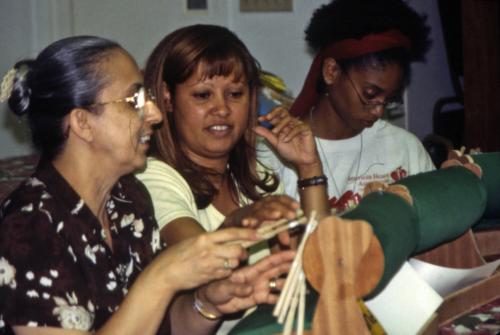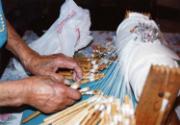Doña América Nieves
Puerto Rican
BiographyBorn and raised in Moca, the center of Puerto Rico's unique mundillo tradition, Doña América Nieves is one of the area's best known lacemakers. She makes all kinds of lace - borders, bodices, collars, baby booties, handkerchiefs, etc. for neighbors and for customers who commission her work. Her styles and designs are numerous and range from simple openwork to detailed and elaborate leaves, flowers, or lattices. Mundillo is made on a "pillow" set into a wooden frame. The paper pattern is pinned to the pillow, the threads are wound onto bobbins which are manouvered and twisted around each other and the pins to form the lace. This technique and particular equipment is found only in Spain and Puerto Rico. Young girls who left school to work in the fields or the factories of northwest Puerto Rico gained income from doing needlework piecework at home for the American clothing companies in the area. Almost every family, including Doña America's, had women who knew mundillo, so it was easy to watch and learn. Doña América taught English in a local community college, and she has traveled to the United States often to demonstrate and give workshops. Her basic workshop curriculum was included in the supplementary materials.
“Doña América Nieves learned to make lace from her mother before she went into first grade. Lacemaking provided a valuable income source for the family during the six months of the year when her father, a sugar cane cutter, had no work. She has continued to make exquisite lace, even while earning a master's degree in education and working as an English teacher. She teaches lacemaking, participates in lace guilds, and demonstrates her art widely in Puerto Rico and the U.S.
Towns such as Moca, Aguadilla, and Isabela in northwest Puerto Rico are the home of a lace making tradition brought to the island by Spanish nuns. Traditional Puerto Rican lace is made on a small loom called mundillo, which has a rotating pillow-shaped drum. A paper pattern is held in place on the cushion with hundreds of pins marking the design. Thread carried on as many as fifty wooden bobbins (called bolillos) is woven around the pins to make the intricate designs take shape. The clicking of the wooden bobbins creates a delicate, musical rhythm.
A common source of income for rural women, lace making was also taught at school, through apprenticeships at workshops, and at needlework factories in the towns. During the second decade of the 20th century needlecrafts such as bobbin lace were in great demand due to their practical use, their timeless beauty, and the fashions of the day. They were used, and still are, in handkerchiefs, tapestry, linens, women's undergarments and clothing, baptismal and wedding gowns, and children's wear. Needlecraft continues to represent an important factor in Puerto Rico's economy.” (Label Copy from Mano a Mano: Puerto Rican Traditional Arts from Island to City)
“Doña América Nieves learned to make lace from her mother before she went into first grade. Lacemaking provided a valuable income source for the family during the six months of the year when her father, a sugar cane cutter, had no work. She has continued to make exquisite lace, even while earning a master's degree in education and working as an English teacher. She teaches lacemaking, participates in lace guilds, and demonstrates her art widely in Puerto Rico and the U.S.
Towns such as Moca, Aguadilla, and Isabela in northwest Puerto Rico are the home of a lace making tradition brought to the island by Spanish nuns. Traditional Puerto Rican lace is made on a small loom called mundillo, which has a rotating pillow-shaped drum. A paper pattern is held in place on the cushion with hundreds of pins marking the design. Thread carried on as many as fifty wooden bobbins (called bolillos) is woven around the pins to make the intricate designs take shape. The clicking of the wooden bobbins creates a delicate, musical rhythm.
A common source of income for rural women, lace making was also taught at school, through apprenticeships at workshops, and at needlework factories in the towns. During the second decade of the 20th century needlecrafts such as bobbin lace were in great demand due to their practical use, their timeless beauty, and the fashions of the day. They were used, and still are, in handkerchiefs, tapestry, linens, women's undergarments and clothing, baptismal and wedding gowns, and children's wear. Needlecraft continues to represent an important factor in Puerto Rico's economy.” (Label Copy from Mano a Mano: Puerto Rican Traditional Arts from Island to City)
Person TypeIndividual











